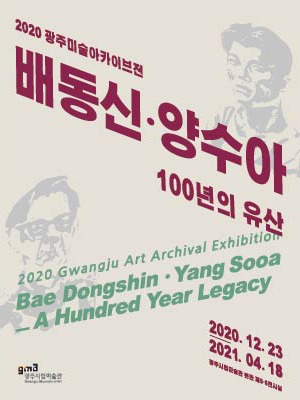
| Period| | 2020.12.23 - 2021.04.18 |
|---|---|
| Operating hours| | Tue - Sun 10:00 ~ 18:00 |
| Space| | Gwangju Museum of Art |
| Address| | 52, Haseo-ro, Buk-gu, Gwangju, Republic of Korea |
| Closed| | Mon., Jan. 1st, Korean Holiday |
| Price| | Free |
| Phone| | 062-613-7100 |
| Web site| | 홈페이지 바로가기 |
| Artist| |
양수아,배동신
|
정보수정요청



|
|
Exhibition Information
Honam is historically known as the ‘region of art’(Yehyang, 예향),’ inheriting a rich artistic tradition. Starting with the Yeosu-born painter Kim Hongsik(1897-1966), leading to Oh Jiho(1905-1982) and Kim Whanki(1913-1974) in the 1930s, an art scene of Western painting began to form, consisting of first-generation painters who returned home after studying Western painting in Japan. Among those who studied in Japan during the tumultuous Pacific War years in the 1940s, Bae Dongshin, Yangsooa, and Kang Yongun are considered to have contributed substantially in paving the way for abstract art. These are the pioneers who first introduced the informal style even before 1957—the year Korea’s central art scene started the Informal movement. Yang Sooa’s early works show the experimental tendencies that preceded his venture into abstract art, while Bae Dongshin’s early Fauvistic portraits reveal the introduction of a new art form. 2020 Gwangju Art Archival Exhibition Bae Dongshin · Yang Sooa_ A Hundred Year Legacy sheds light on the artistic oeuvre of the two masters. Bae Dongshin held on to watercolor throughout his life and thereby widened the spectrum of Korean watercolor painting, while Yang Sooa expanded the horizon of Korean modern art by transforming the dreams and failures of a turbulent history into art. The exhibition will be an opportunity to pay tribute to the fierce artistic passion of the two artists and to reassess the vestiges of Korean modern art. Bae Dongshin _ A Hundred Year Legacy The tradition of watercolor painting remained rather static in Korea until 1945. There were only a handful of watercolor painters, including Lee Insung from Daegu and a few in Seoul. Unlike Korean traditional painting or oil painting, watercolor painting was not accepted as an established art form, often disregarded as a preliminary step in art training. Bae Dongshin elevated this barren field into a proper artistic discipline. Since the formative years of the Western-style art scene, he persisted in watercolor paintings, pursuing harmony between the East and the West for over 70 years. As such, he is recognized as the leading first-generation painter of Korean modern art, a master of watercolor painting who expanded the horizons of this discipline. Bae Dongshin believed that “the mentality of the Korean people are better expressed in water than oil,” dedicating his whole life to watercolor painting than oil painting. Bae became one of the representative figures of the period who established a distinctive aesthetic based on technique; he not only tenaciously expressed the Eastern sentiments but also integrated traditional methodologies with modern painting styles. This exhibition will introduce his major works including Mudeungsan, Nude, Still Life, Port, Self Portrait, Drawing as well as archival materials such as photos and brochures. Yang Sooa _ A Hundred Year Legacy While abstractionism was reaching its peak in the West in 1945, Korean painters who have studied in Japan were still following the academic style. Especially in the Honam region, where the tradition of Namhwa(Southern school of Chinese painting) prevailed, Oh Jiho’s naturalistic Western-style paintings were in the mainstream, inheriting the genealogy of Sochi Heo Ryeon(1808-1893), Misan Heo Hyung(1982-1938), Namnong Heo Kon(1907-1987), and Uijae Heo Baekryeon(1891-1977) who combined Namhwa landscape paintings and impressionism to apply it to the nature of the Southern province. Amongst such conservative tendencies, it was difficult to bring in new forms of modern art. Having experienced the post-war period in 1945 and the Korean war in 1950, Yang Sooa presciently saw the arrival of abstractionism in Korean modern art even before 1957—the year Korea’s central art scene started the Informel movement. He was a pioneer in the history of Korean modern painting who transformed the agony and anger of Korea’s tumultuous modern history into a new, nonfigurative art form through his artistic soul. On display at this exhibition are his figurative and nonfigurative artworks, Self Portrait, Drawing, and archival materials such as photos and illustrations.
